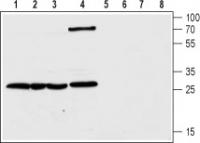CLIC1 Rabbit Polyclonal Antibody
Frequently bought together (3)
beta Actin Mouse Monoclonal Antibody, Clone OTI1, Loading Control
USD 200.00
Other products for "CLIC1"
Specifications
| Product Data | |
| Applications | IF, WB |
| Recommended Dilution | WB: 1:200-1:2000; FC: 1:50-1:600 |
| Reactivities | Human, Rat |
| Host | Rabbit |
| Clonality | Polyclonal |
| Immunogen | Peptide (C)RGFTIPEAFRGVHR, corresponding to amino acid residues 195-208 of human CLIC1. Intracellular, C-terminus. |
| Formulation | Lyophilized. Concentration before lyophilization ~0.8mg/ml (lot dependent, please refer to CoA along with shipment for actual concentration). Buffer before lyophilization: Phosphate buffered saline (PBS), pH 7.4, 1% BSA, 0.05% NaN3. |
| Reconstitution Method | Add 50 ul double distilled water (DDW) to the lyophilized powder. |
| Purification | Affinity purified on immobilized antigen. |
| Conjugation | Unconjugated |
| Storage | Store at -20°C as received. |
| Stability | Stable for 12 months from date of receipt. |
| Gene Name | chloride intracellular channel 1 |
| Database Link | |
| Background | Chloride intracellular channel (CLIC) is a family of proteins encoded by six different genes (CLIC1-6). The localization of the various CLIC channels remains elusive and controversial since they can be either found in a soluble form in the cytoplasm or as integral membrane proteins (in intracellular compartments such as the nuclear membrane or the endoplasmic reticulum for example, or associate to the plasma membrane) via their single transmembrane domain. When membrane associated, CLIC channels indeed function as ion channels (enabling the passage of Cl ions). Non-channel functions are also attributed to CLICs and include cell cycle regulation, cell differentiation, and apoptosis. These different roles depend whether CLICs are membrane bound or cytosolic. CLIC1, which was first identified in nuclear membranes, is detected in the epithelia of airways, the gall bladder, pancreas, stomach, small intestine and colon. CLIC1 was also found to be expressed in the endothelium where it plays a role in cell growth and migration. |
| Synonyms | G6; NCC27 |
| Reference Data | |
| Protein Families | Druggable Genome, Ion Channels: Other |
Documents
| Product Manuals |
| FAQs |
| SDS |
{0} Product Review(s)
0 Product Review(s)
Submit review
Be the first one to submit a review
Product Citations
*Delivery time may vary from web posted schedule. Occasional delays may occur due to unforeseen
complexities in the preparation of your product. International customers may expect an additional 1-2 weeks
in shipping.






























































































































































































































































 Germany
Germany
 Japan
Japan
 United Kingdom
United Kingdom
 China
China




